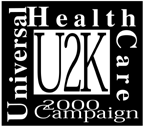Intro | Private Ins. | Medicare | Medicaid | Managed Care | Crisis | Reform

|
Medicaid |
History
Medicaid was enacted in 1965, as part of President Johnson's Great Society. Unlike Medicare, it was not the subject of prolonged political advocacy and debate. It was added to the Medicare package near the end of the legislative debate to provide care to people who are medically indigent. Prior to Medicaid, this care was mostly financed at the local level by counties, with some assistance from states. Consequently Medicaid became a shared federal-state program, unlike Medicare, which is a purely federal program.
Unlike Medicare, which provides universal coverage to the elderly regardless of income, Medicaid eligibility depends on income (a "means-tested program"). In the 1980s, Congress passed legislation requiring increases in eligibility by age through childhood and adolescence. In 1997, Congress encouraged the states to increase income eligibility through CHIP (the Child Health Insurance Program).
Medicaid provides insurance to low-income families with young children, to people with disabilities and to the impoverished elderly, particularly those with expensive nursing home bills.
Current Status:
1996 Medicaid coverage and expenditures:
| #covered | $ total expend | $ per capita | |
| Children | 21,270,000 | $24.2 billion | $ 1115 |
| Adults | 9,210,000 | $16.9 billion | $ 1837 |
| People with disabilities | 6,690,000 | $56.9 billion | $ 8505 |
| Elderly | 4,089,000 | $42.1 billion | $10,296 |
Percentage of nonelderly covered under Medicaid, 1988-1996:
| 1988 | 8.7% |
| 1990 | 10.2% |
| 1992 | 11.8% |
| 1994 | 12.5% |
| 1996 | 12.1% |
Medicaid spending as a % of total spending, by sector, 1995:
| Hospitals | $51 billion | 14.7% |
| Doctors | $14.5 billion | 7.4% |
| Nursing homes | $35.5 billion | 47.2% |
Federal share of Medicaid expenditures (1996):
Average: 56.9%
Low federal share, 50 to 51%: Alaska, California, Connecticut, Delaware, DC, Hawaii, Illinois, Maryland, Massachusetts, Nevada, New Hampshire, New Jersey, New York, Washington.
Mid range share, 55-60%: Florida, Kansas, Michigan, Nebraska, Wisconsin, Wyoming
High range share, 70-78%: Arkansas, Kentucky, Louisiana, New Mexico, South Carolina, Utah, West Virginia
Current Policy Issues
Before the 1996 welfare reform, all families on welfare automatically qualified for Medicaid, though the programs are actually separate. With TANF (Temporary Assistance to Needy Families), many who qualify for Medicaid but not cash benefits are falling through the cracks when their cash assistance ends. In many states, administrative confusion in welfare agencies has hindered the enrollment of those who qualify. The outreach effort to enroll children in the CHIP program has fallen far short of expectations.
Freedom of choice had for decades been a key aspect of Medicaid. Claiming it would save money, many states in the mid 1990s forced Medicaid recipients into HMO's. In a large number of these states, Medicaid HMO's have gone out of business, as a consequence of managerial incompetence, fraud or both. There is no convincing evidence that the HMO experiment has saved money for Medicaid. Although Medicaid spending by states has recently declined, it is mostly because of lower enrollment related to changes in welfare.